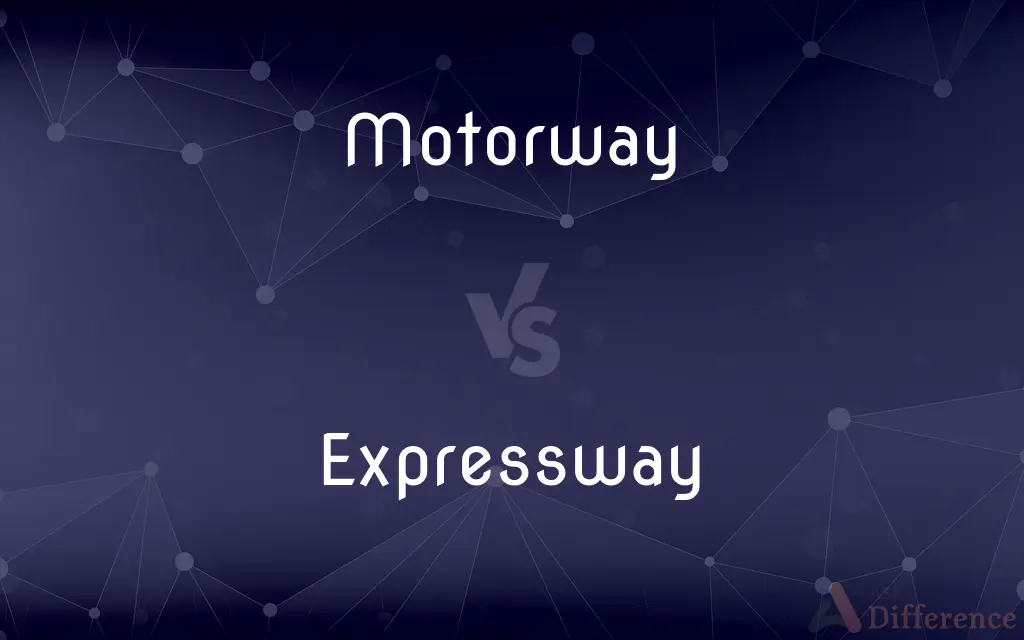Motorway vs. Expressway — What's the Difference?
Edited by Tayyaba Rehman — By Fiza Rafique — Updated on March 27, 2024
Motorways are high-speed, controlled-access highways designed for long-distance travel, typically with no traffic lights or intersections, whereas expressways may have controlled access but can include occasional intersections or traffic lights.

Difference Between Motorway and Expressway
Table of Contents
ADVERTISEMENT
Key Differences
Motorways, also known as freeways or interstates in some countries, are designed exclusively for fast vehicular traffic. They feature multiple lanes, usually separated by a central barrier, with entry and exit points controlled by slip roads (ramps). Whereas expressways are also designed for rapid travel but may not always have full control of access, meaning they can include at-grade intersections, traffic signals, or roundabouts in some sections.
The design of motorways ensures uninterrupted flow of traffic, with overpasses and underpasses allowing for the crossing of other roads, railways, or pedestrian paths without intersections. On the other hand, expressways are designed to limit but not completely eliminate interruptions, aiming to keep traffic flowing smoothly while accommodating more varied types of intersections and access points.
Motorways typically do not allow for any type of non-motorized traffic, such as pedestrians, bicycles, or horse-drawn vehicles, and often restrict the types of motor vehicles allowed, banning slower and smaller vehicles like mopeds. In contrast, expressways might have fewer restrictions, allowing for a broader range of vehicles, including those not permitted on motorways, depending on local laws.
Safety features on motorways include wide lanes, ample shoulder room, crash barriers, and high-visibility signs. These features are designed to support high-speed travel and reduce collision risks. Expressways also prioritize safety but may face challenges in maintaining the same level of safety due to potential conflicts at intersections and the presence of a wider variety of vehicles.
Despite their differences, both motorways and expressways play crucial roles in modern transportation networks, facilitating efficient travel across urban and rural areas. Motorways are key for long-distance travel and heavy freight movement, while expressways provide vital connectivity with more flexibility in urban planning and access.
ADVERTISEMENT
Comparison Chart
Access Control
Full control, no at-grade crossings
Partial control, may have at-grade crossings
Traffic Lights
None
May have traffic lights at some intersections
Intersections
None, only grade-separated junctions
Few, can include at-grade or grade-separated junctions
Vehicle Restrictions
High, excludes non-motorized and slow vehicles
Lower, more types of vehicles allowed
Typical Features
Multiple lanes, central barrier, no direct property access
Multiple lanes, occasionally central barriers, some direct access
Safety Features
Wide lanes, ample shoulder room, crash barriers
Safety features vary, generally fewer than motorways
Designed For
Long-distance, high-speed vehicular traffic
Rapid travel with higher accessibility and flexibility
Interconnectivity
Typically part of national or regional networks for through traffic
Connects regions or urban centers, sometimes to motorways
Compare with Definitions
Motorway
Part of a larger network connecting various regions.
The motorway network facilitates national and international freight and passenger movement.
Expressway
Designed for efficiency in both urban and interurban settings.
Expressways serve as key arteries within urban planning, linking neighborhoods and cities.
Motorway
Aimed at reducing travel time and increasing safety.
The wide lanes and crash barriers on motorways enhance safety for high-speed travel.
Expressway
Balances high-speed travel with accessibility to local roads.
Expressways allow for faster commutes while accommodating more direct access points.
Motorway
Designed exclusively for vehicular traffic, barring pedestrians and non-motorized vehicles.
Motorways ensure uninterrupted flow, making long-distance travel more efficient.
Expressway
May include features like at-grade crossings and traffic signals.
While expressways streamline travel, drivers may encounter traffic signals in denser areas.
Motorway
A high-speed, controlled-access highway with no at-grade crossings.
The M1 motorway connects major cities across the country, facilitating swift travel.
Expressway
A rapid transit route with controlled access but may have intersections.
The expressway improves connectivity between the city and suburbs, despite occasional lights.
Motorway
Features include multiple lanes and grade-separated junctions.
Motorways use ramps for entering and exiting, avoiding stoplights and direct property access.
Expressway
Supports a wider variety of vehicles than motorways.
Expressways can accommodate both high-speed vehicular traffic and slower, local traffic.
Motorway
A dual-carriageway road designed for fast traffic, with relatively few places for joining or leaving.
Expressway
An urban motorway.
Motorway
An expressway.
Expressway
A major divided highway designed for high-speed travel, having few or no intersections. Also called freeway, limited access highway, superhighway, thruway.
Motorway
(In Europe, New Zealand and parts of Australia) A highway with grade-separated crossings (rather than level crossings) and designed (and only permitted) for high-speed motor-traffic (in Europe motor vehicles with a higher speed limit than 40 km/h) running in two directions on one separate carriageway each
Expressway
A divided highway, especially one whose intersections and direct access to adjacent properties have been eliminated.
Motorway
(Chiefly in the U.S.) A racetrack venue designated especially for the sport of auto racing.
Expressway
A road built to freeway standards.
Motorway
A broad highway designed for high-speed traffic
Expressway
A road built for high speed traffic, but not up to motorway standards or designated a motorway.
Expressway
A broad highway designed for high-speed traffic
Common Curiosities
Can you enter a motorway via any road?
Entry and exit are controlled via specific ramps or slip roads, not direct access.
Why are motorways safer than other roads?
Their design minimizes conflicts and interruptions, reducing collision risks.
Can expressways have traffic lights?
Yes, expressways may have traffic lights, especially in urban areas or at major intersections.
Are expressways part of urban or rural infrastructure?
They can be both, facilitating rapid travel in urban settings and between cities.
Are there tolls on motorways?
Some motorways are toll roads, requiring payment for access.
What vehicles are not allowed on motorways?
Non-motorized vehicles, pedestrians, and very slow-moving vehicles are typically banned.
How do motorways differ from highways?
Motorways are a subset of highways with full control of access, designed for high-speed travel.
What makes expressways different from motorways?
Expressways have more flexible access control and can include at-grade crossings.
Do expressways connect to motorways?
Often, expressways serve as feeder routes to motorways or link different motorways.
How do expressways handle pedestrian crossings?
Pedestrian crossings on expressways are typically managed via overpasses or underpasses.
Share Your Discovery

Previous Comparison
Arrestor vs. Arrester
Next Comparison
Persevere vs. EndureAuthor Spotlight
Written by
Fiza RafiqueFiza Rafique is a skilled content writer at AskDifference.com, where she meticulously refines and enhances written pieces. Drawing from her vast editorial expertise, Fiza ensures clarity, accuracy, and precision in every article. Passionate about language, she continually seeks to elevate the quality of content for readers worldwide.
Edited by
Tayyaba RehmanTayyaba Rehman is a distinguished writer, currently serving as a primary contributor to askdifference.com. As a researcher in semantics and etymology, Tayyaba's passion for the complexity of languages and their distinctions has found a perfect home on the platform. Tayyaba delves into the intricacies of language, distinguishing between commonly confused words and phrases, thereby providing clarity for readers worldwide.















































